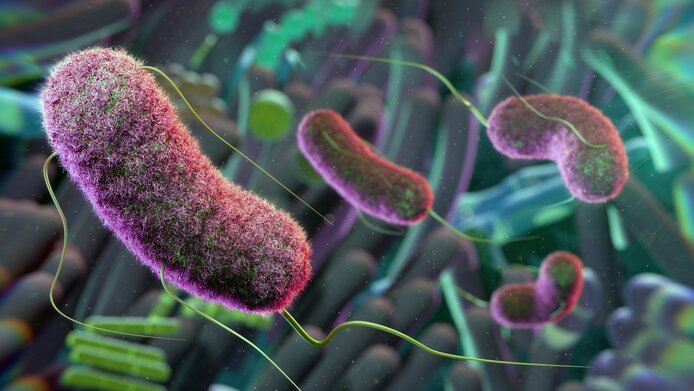When muscles waste away

The human body is like an ecosystem colonized by microorganisms. Bacteria perform a multiplicity of tasks, supporting digestion and immune defense, for instance. Researchers at the Medical University of Graz have now discovered, however, that an unfavorable composition of the gut microbiome is linked to sarcopenia, or muscle loss. This insight was derived from studies on patients with chronic liver disease. With more than 1,100 cases per 100,000 individuals, Austria has the second highest number of people with chronic liver disease in Europe after Romania.
Axis between liver and muscle discovered
The FWF-funded clinical research project “The gut-liver-muscle axis in liver cirrhosis” identified bacterial strains that occur more frequently when both liver cirrhosis and muscle atrophy materialize in a patient. Gut bacteria are responsible for the conversion of unchanged (primary) bile acids into secondary bile acids in the digestive tract. The study showed that the altered gut microbiome led to an above-average increase in certain secondary bile acids in the study participants.
“The results suggest that the bile acid products enter the muscle via the bloodstream and cause damage there,” explains Vanessa Stadlbauer-Köllner, the principal investigator, who is Professor of Translational Microbiome Research and Hepatology at the Medical University of Graz. She now intends to contribute to the development of new therapies that specifically influence the intestinal microbiome.
New insights into bile acids
For the clinical research project, Stadlbauer-Köllner's team recruited 217 people with and without liver cirrhosis and divided them into those with and without muscle loss disorder (sarcopenia). They compared samples and found bacterial strains such as Bacteroides fragilis, Blautia marseille, Sutterella spp. and Veillonella parvula with greater frequency in participants with sarcopenia. In contrast, Bacteroides ovatus appeared to have a positive effect and was present in those who did not show muscle wasting despite having cirrhosis of the liver. In addition, the team found that the unfavorable bacterial strains produced more secondary bile acids.
It had not been clear at the outset that bile acids would play such an important role as a connecting element. “In the past, bile acids were seen as a sort of rinse for the intestine that helps with fat digestion. Today we know that the substances can act as hormones on other cells,” says Stadlbauer-Köllner. Cell culture tests have shown that secondary bile acids damage muscle cells. In a follow-up project, Stadlbauer-Köllner now wants to investigate whether this also happens in the human body. She suspects that the substances enter the bloodstream through an impaired intestinal barrier in chronically ill people.
Muscle waisting: a serious problem
Sarcopenia is a serious problem in many chronic diseases and also in old age. Stadlbauer-Köllner specializes in chronic liver diseases in her research as a result of her work as head of the internal medicine liver transplant outpatient clinic in Graz. “Muscle atrophy can lead to extremely stressful situations. Sometimes people are too weak to undergo a liver transplant to overcome their liver disease,” says Stadlbauer-Köllner, illustrating the difficulties in everyday medical practice.
“Unfortunately, most people don't know about their illness until they have to go to hospital because of a serious complication,” says Stadlbauer-Köllner. This is because liver cirrhosis, the final stage of liver damage, is usually preceded by lengthy processes. The most common triggers are infections with hepatitis B or C viruses, alcohol consumption, autoimmune diseases or metabolic diseases such as obesity or diabetes mellitus.
FWF funding program for clinical studies
The identification of the bacterial strains was a first step towards a targeted therapy that promotes or directly supplies beneficial intestinal bacteria. Stadlbauer-Köllner is also researching the effect on the microbiome and muscle of a drug containing special amino acids. The FWF-funded project has provided the foundation for these therapeutic approaches. “This funding program of the Austrian Science Fund FWF is very valuable for medical research,” notes Stadlbauer-Köllner. “For many years, this was the only funding instrument for us translational researchers to be able to research therapies independently.”
Interest in the gut microbiome has now spread beyond laboratories to the general public, not least because the world's first drug to treat the microbiome was approved in the USA last year. Nevertheless, Stadlbauer-Köllner warns that we need to be patient. “Hopes are currently higher than what is achievable for science,” says the physician. “There is a lot of potential in microbiome research, but also a lot of basic work that still needs to be done.”
Personal details
Vanessa Stadlbauer-Köllner is a gastroenterologist and hepatologist. In her clinical work, she heads the internal-medicine liver transplant outpatient clinic at the Medical University of Graz. As a researcher, she heads the Translational Microbiome Regulation working group at the Medical University of Graz and the Translational Precision Medicine department at CBmed, a research institute in Graz.
The project “The gut-liver-muscle axis in liver cirrhosis” (2019-2023) was funded by the Austrian Science Fund FWF with 384,000 euros. The project also received funding of 57,000 euros from the FWF's “Crisis Support for Researchers from Ukraine” program, which enabled Ukrainian researcher Olha Hazia to significantly expand the scope of the project.
Publications
Horvath A., Zukauskaite K., Hazia O., Balazs I., Stadlbauer V.: Human gut microbiome: Therapeutic opportunities for metabolic syndrome-Hype or hope?, in: Endocrinology, Diabetes & Metabolism 2024
Aliwa B., Horvath A., Traub J., Feldbacher N. et al: Altered gut microbiome, bile acid composition and metabolome in sarcopenia in liver cirrhosis, in: Journal of Cachexia, Sarcopenia and Muscle 2023
Missing Link
A clinical study has revealed a previously unknown link between the gut microbiome, the production of bile acid, and muscle wasting. This could give rise to new therapies targeting healthy gut bacteria.





